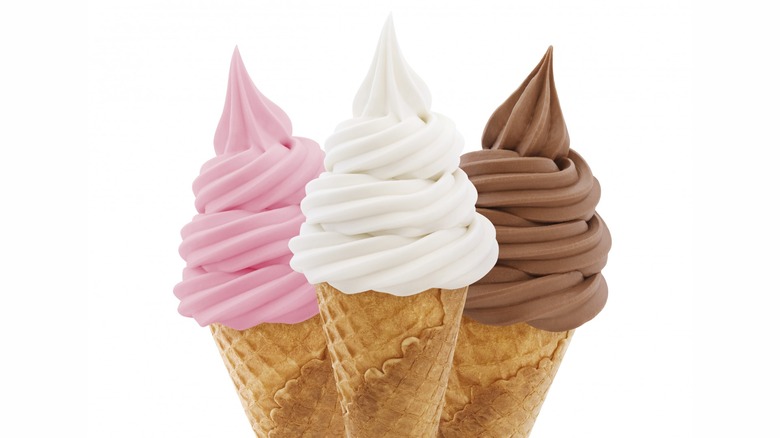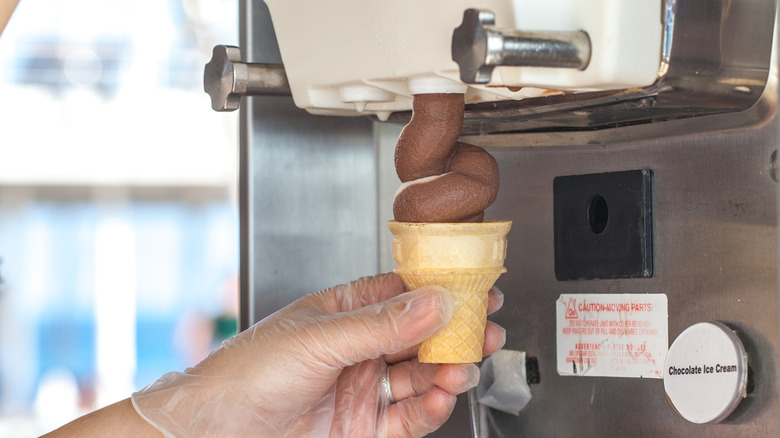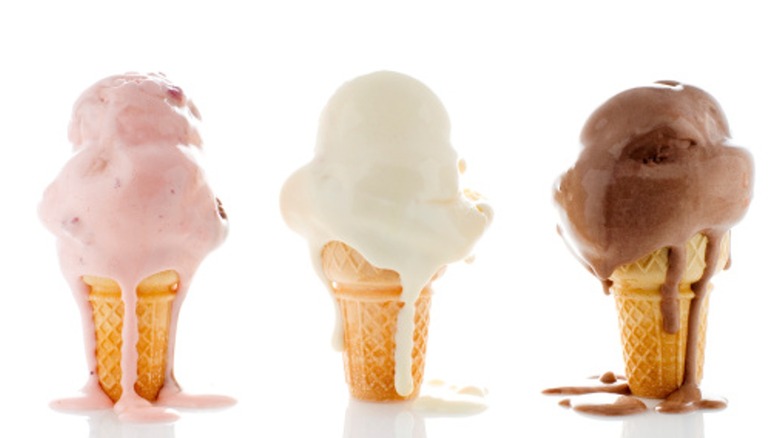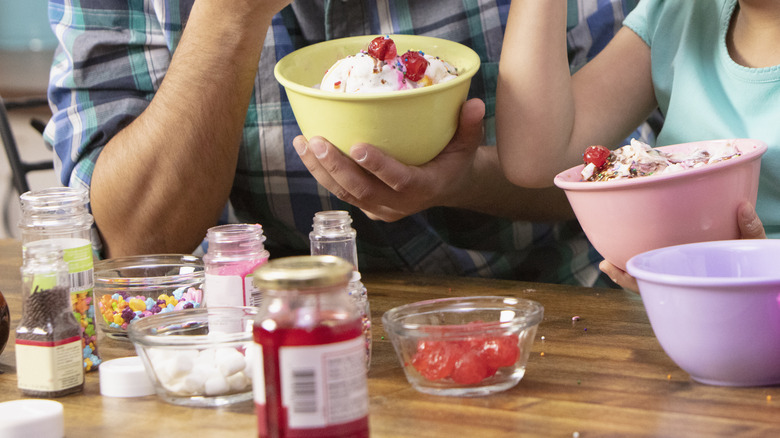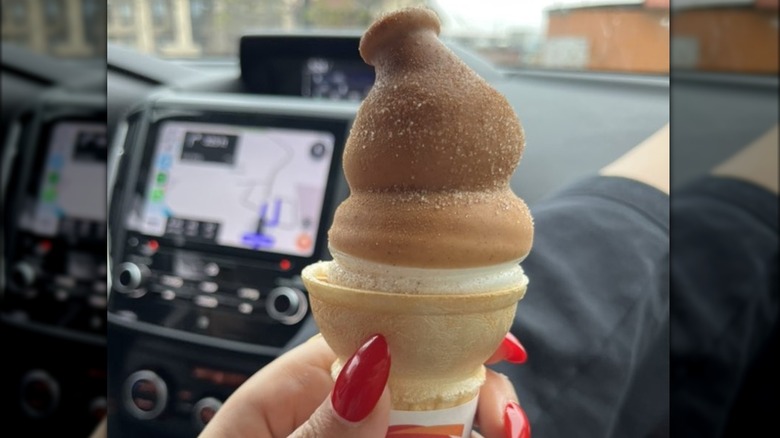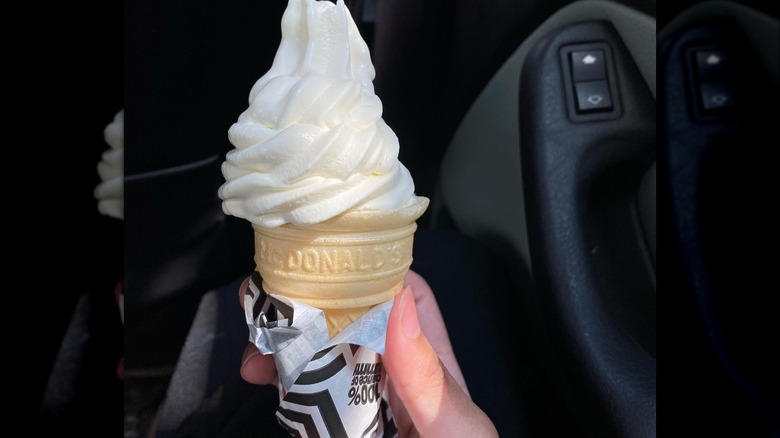What Really Makes Soft Serve Taste So Good
Like the old saying goes, there's always room for ice cream. Our apologies to Jell-O for usurping its famous catchphrase, but the modern dessert seekers simply aren't enticed by gelatin and pudding products the way their antiquated brethren might've been. Of course, the frosty, creamy, unparalleled deliciousness offered by quite literally any type of non-savory ice cream is different. We can't imagine a single person (beyond lactose intolerant individuals) turning down a cone or cup — whether it's hard ice cream or soft serve.
Before any sticklers decide to get snooty (snooty?) or snotty (snotty?), we concede soft serve may not technically qualify as ice cream by some definitions. Yet no matter how one chooses to categorize this delightful dessert — one so beloved that TV's Kimmy Schmidt (Ellie Kemper) believed in the existence of a smiling chocolate soft serve emoji (hint: It's not ice cream) — soft serve undoubtedly offers a unique-yet-familiar alternative to traditional ice cream.
Now, simply stating "soft serve tastes delicious" reveals little to no information regarding why and how it's such a superbly fantastic frozen concoction. Given our innate interest in what precisely makes soft serve so great, we decided to research those underlying details with the same enthusiasm as a toddler digging into a chocolate-vanilla swirl. If you, too, are curious how this frozen treat's swirling glory consistently knocks it out the park, keep reading as we discuss what really makes soft serve taste so good.
An increase in overrun gives soft serve its signature fluffiness
Beyond the simple fact that soft serve essentially can't (and doesn't) exist unless it's poured directly from a machine at a restaurant (hold that thought), the dessert's superiorly airy contrast to regular ice cream may be its most identifiable aspect. But soft serve isn't just fluffier than other ice cream by chance. The reason for its signature consistency comes from the additional overrun incorporated into soft serve (compared to traditional ice cream) during the freezing process.
For the unfamiliar — a list we presume includes most readers — overrun is merely the term used to describe how much air is actually included in ice cream. After all, even hard-packed ice cream includes a fair amount of overrun, as your dairy-based sweet treat would otherwise be as dense as a brick. More than that, adding air to ice cream appears to significantly increase the total amount produced, resulting in a greater overall output — meaning more ice cream to eat (or sell).
Of course, while regular ice cream may have around 35% overrun, soft serve tends to contain between 50% and 60% overrun. Unsurprisingly, that additional air makes an enormous difference when it comes to soft serve's cloud-like appearance (as well as its iconic mouthfeel).
It may be less likely to cause brain freeze than other ice cream varieties
Some individuals may be immune to the devastating agony caused by brain freeze and are able to ingest scoop after scoop of a frozen product like ice cream without fear of that crippling pain. Unfortunately, the rest of us remain perplexed by the phenomenon technically known as sphenopalatine ganglioneuralgia. In that sense (and with your sensory input in mind), one of the more appealing aspects of soft serve is that it's quite literally warmer than regular ice cream — temperature-wise, we mean — and therefore less likely to induce an ice cream headache.
Seeing how soft serve is still a frozen treat, we don't mean to imply that it's produced at a drastically higher temp than regular ice cream, or that it's served above 32 degrees Fahrenheit. No one's ordering a chocolate-vanilla soft serve soup, after all — though in all honesty? That sounds phenomenal.
Either way, hard ice cream is generally stored at about 10 degrees Fahrenheit, while soft serve tends to be kept (and served) around 21 degrees Fahrenheit. Even if the difference seems negligible, that extra 10 degrees or so makes soft serve less potentially punishing on the palate upon ingestion — and that reduced risk of brain freeze explains a key part of soft serve's greatness.
Soft serve harkens to the deliciousness of melted ice cream
We joked earlier about the potentially delectable flavors found in a bowl of melted soft serve, aka soup. Interestingly enough, though, the idea of eating a fully liquified serving of soft serve — or any type of melted ice cream product, for that matter — isn't just some humorous aside. In fact, part of what makes soft serve taste so good is that it actually does evoke the experience of eating melted ice cream.
Now, if you're unsure why soft serve being somewhat akin to melted ice cream works in its favor, consider that meltier ice cream actually does taste better on your tongue than colder varieties. This is sort of easy to understand, though, since the warmer temperature of melted ice cream ensures a person's taste buds remain active rather than dulled by the cold — allowing the dessert's sugar-centric greatness to shine more prominently.
Beyond any scientific explanation, there's also the potential origin story of soft serve to keep in mind. As the legend goes, Tom Carvel (yes, that Carvel) was forced to sell a batch of partially melted product as a supposed soft ice cream after a truck mishap in 1934. Since folks were over the moon for the soft-style ice cream, it led to soft serve's creation — meaning melted ice cream was the apparent inspiration behind soft serve's very existence.
A bevy of food additives and preservatives ensures its consistent texture
If we asked you to name what's in ice cream — as in the actual ingredients — two specific items likely spring to mind: cream and sugar. Of course, even a high-quality version of the frozen dairy dessert contains more than that expected pair of ingredients (don't forget about the overrun, kids!) — and soft serve is no different. More than that, the number of food additives commonly found in soft serve appears largely responsible for its almost staggeringly consistent perfection.
To be clear, we can't say whether every single solitary soft serve recipe or mix utilizes the same common (and often difficult-to-spell) ingredients. Yet it's just as obvious that soft serve's smooth, velvety texture is generally enhanced by, say, cellulose gum — a plant-derived thickening agent — and that it remains fully blended and emulsified thanks in part to the inclusion of mono- and diglycerides from fatty acids.
We're not trying to scare away any soft serve fans from consuming it in the future by revealing it's not exactly a minimally processed item. But the bottom line is you can't dismiss the presence — or impact — of numerous food additives and preservatives when discussing what really makes soft serve taste so good.
The additional air literally makes soft serve taste lighter than alternatives
By now, we assume all readers are familiar with the fact that any and all varieties of ice cream include a substantial percentage of air (known as overrun, of course). Additionally, we've established there's more overrun contained in soft serve than your average pint of Ben & Jerry's. It's fairly obvious, then, what really makes soft serve taste so good: It's quite literally lighter-tasting than regular ice cream because it is, in fact, lighter with regard to density and mass.
With a surplus of air incorporated during the freezing process, soft serve is less likely to sink into your stomach like an anchor. That's not to say the extra air acts as a lifeboat in your digestive system. But then again? That analogy sort of works. After all, more air in the final product means there's less room for sugar or fat in soft serve — and less chance those unhealthy substances will wreak nutritional havoc.
Since the airy and fluffy texture of soft serve is also noticeable in your mouth and on your tongue (as anyone who's ever eaten it knows), it seems clear its lighter overall composition plays a crucial hand in its deliciousness.
The simplicity of soft serve is tough to beat
There are numerous flavors and types of ice cream on the market — and seemingly just as many avenues to order and consume the frozen treat. From the bevy of sundaes, banana splits, and frappes (or milkshakes, as the ice cream-based beverage is known outside Massachusetts), the breadth of choices can make your head spin like a possessed Regan MacNeil (Linda Blair) in "The Exorcist." In that regard, part of what makes soft serve so great is its generally simplified selection process — with the menu often consisting of chocolate, vanilla, or the classic swirl (we'll get to that beauty shortly).
Perhaps this aspect of soft serve is appealing because it harkens back to a time before consumers were faced with virtually unlimited options in nearly every facet of life. Now, we're not oblivious to the fact that complaining about the ability to essentially obtain whatever you'd like at any given time is the epitome of first-world problems — and we greatly prefer to live in a world where the risk of choice overload is more prevalent than a lack of options.
Still, it's nice to give your mental muscles the occasional break by simplifying certain decision-making processes. And since soft serve provides a much easier serving process for restaurants, it's not only easier to decide your order — it'll come faster than regular ice cream, too.
Its lack of home availability makes it seem more special than regular ice cream
Similar to the way pancakes always taste better when ordered from (and eaten at) a restaurant, there's something to be said for the sheer fact that soft serve is only available outside the home. Soft serve isn't usually packaged and sold in pints or quarts like other ice cream varieties, after all, because, well ... it can't be without sacrificing its signature feathery texture. Since we've been conditioned to expect a very specific consistency from soft serve every time, its distinction as a dine out-only option makes it seem more enticing than it might otherwise be.
Now, if you've ever wondered why the universality of ice cream in freezer aisles across the globe doesn't include soft serve, it's clearly not for lack of desire. Rather, the reason soft serve remains relegated to restaurants and ice cream stands is because its slightly warmer temperature and uniquely fluffy-yet-creamy quality can't be maintained in a home freezer.
Given that the dessert is an out-of-the-house option, a number of people may also associate soft serve with past social outings. And seeing how social get-togethers (like eating out) are known to increase an individual's feelings of happiness, it only serves to boost soft serve's status among culinary sweets.
The soft serve swirl is a delectable work of art
It's a well-established fact that we don't just eat with our mouth. Our olfactory system plays an important part in our ability to enjoy basically any food we ingest — as does our sight. In fact, if a food item looks like a certain smiling brown emoji (which is not chocolate soft serve), you're unlikely to derive as much satisfaction from it as you could with something that visually dazzles — like the classic chocolate-vanilla soft serve swirl.
Now, we'd never bark out demands for a restaurant owner to swirl it like a hungry, post-game Little Leaguer — the potential wrath of chefs like Bob Belcher (H. Jon Benjamin) of "Bob's Burgers" makes us shudder, after all. But we also can't deny a tall, perfectly poured chocolate-vanilla swirl (in a cone or a cup) is like music for the eyes.
The utter simplicity of the classic swirl's presentation (and delectable flavor profile) works in its favor. Whether it's crafted by a bored teenager working over summer break or a cutting-edge robot specifically designed to create impeccable swirls, it's tough to beat the aesthetic wonder (or taste) of chocolate spun together with vanilla. Sometimes, less truly is more.
Dipped soft serve cones are a unique delight
It's sort of easy to accept that soft serve tastes great because it's a miracle of modern science (there's a reason why other ice cream varieties pre-date soft serve by centuries). Along those lines, one of the more incredible ways to present and consume soft serve is with a dipped cone — like the well-known line of dipped cones sold by Dairy Queen.
Now, DQ's classic chocolate-dipped cone features a crunchy outer layer akin to what you'd get with a magic shell – meaning there's nothing stopping a person from taking a regular ice cream cone made with a traditional, hand-scooped product and dousing (or dunking) it in a similar coating. But can a cone made with uneven, misshapen scoops of hard ice cream match up to the incomparable aesthetics found from a dipped cone prepared with a beautifully hand-spun serving of soft serve? Not ... even ... close, bud.
Quite frankly, just like soft serve itself, the dipped cone represents a fun variation on the typical consumption of ice cream and provides a nice textural contrast to the frozen treat's air-made fluffiness to boot.
Soft serve tends to evoke memories of social activities and outings
It should come as no surprise that soft serve tastes so good, in part, because it's often enjoyed with other people. After all, we've already established the difficulties with maintaining the not-as-frozen dessert's quality and consistency in a standard freezer makes it ripe for shared enjoyment (since you can't buy and serve soft serve at home). But whether it's shared memories of consuming soft serve cones at a fast food joint, a local fair, or any other location, the fact that it tends to conjure thoughts of past (and future) social outings elevates it among many modern desserts.
The inherent connection between soft serve and social gatherings — as in the type that can increase a person's overall satisfaction levels – may be just as crucial to its overall popularity as its taste and texture. Actually, on second thought? Soft serve wouldn't exist at all without its unbelievably glorious flavor profile, so we won't go so far as to declare that the social component is equally important.
Still, there's no denying the tendency to remind folks of joyous occasions with friends and family is a notch in soft serve's favor.
It may be slightly healthier than hard ice cream (relatively speaking, that is)
We want to make it clear up front that no frozen ice cream (or ice cream adjacent) treat is necessarily healthy. Even soft serve should be consumed in moderation (that's the key to life, some might say). Still, when it comes to regular hard ice cream versus soft serve, there's no mistaking the warmer, fluffier frozen dessert takes the cake (or waffle cone) with regard to nutritional impact.
The additional air contained in soft serve compared with other ice cream products is critical to explaining its supposedly healthier stature — and it's fairly easy to see why. After all, the additional overrun incorporated in soft serve leaves less room for other components like sugar and fat, resulting in a food item that's lighter in more ways than one.
In short, it may not be exactly accurate to describe soft serve as a healthy alternative to other types of ice cream. But to say it's slightly healthier is entirely fair — which we'd predict causes some people to derive additional joy from it.
Soft serve's status as a fast food staple makes it widely available and affordable
Name a fast food restaurant chain, and there's a decent chance it offers some variety of frozen dessert on its menu. Of course, given the logistical challenges posed by serving hard ice cream — and its propensity to potentially gum up the works inside a fast food kitchen by increasing order prep time — it's no wonder so many establishments choose instead to sell a machine-poured (and drastically easier) soft serve product.
Now, if you're curious how soft serve being widely available at various fast food locations around the U.S. makes it taste so good, consider its often affordable price tag at such restaurants. Maybe it's us, but we just love a bargain, so the generally cost-effective price for fast food soft serve products brings a smile to our faces.
Additionally, the relatively ubiquitous nature of fast food in the 21st century means soft serve isn't all that difficult to obtain. And with at least 12 different chains serving some variety of soft serve as of 2023, who can't appreciate the ability to grab a cone from a nearby fast food spot whenever the mood strikes?
